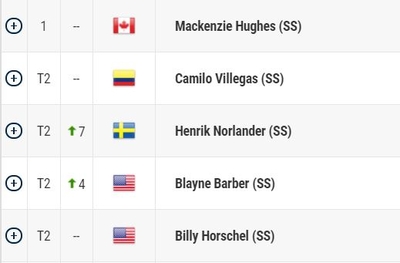 Dead heats occur in a number of sports and whilst they are perhaps most closely associated with horseracing, they are also an extremely common occurrence in golf.
Dead heats occur in a number of sports and whilst they are perhaps most closely associated with horseracing, they are also an extremely common occurrence in golf.
They have nothing to do with the temperature.
There are often so many players competing that you might even find more than one in several positions towards the top of the table.
Here we explain what dead heat rules are and how they work and why they crop up so much in golf betting.
We will also take a look at some of the sport’s most famous and most spectacular dead heats from its long and illustrious past.
What Is A Dead Heat And How Does It Relate To Golf?
As said, dead heats can happen in many sports and, in essence, the term describes a tie in a multi-participant event, where no further means of separating the teams, players, horses or golfers is used. The simplest example concerns the sport where the phrase is thought to have originated: horseracing. If two (or more) horses cross the finish line at exactly the same time and cannot be separated, even with the use of photo-finish technology, this is classified as a dead heat.
Whether the horses “tie” for first place, second, or anywhere else, the dead heat means they have both jointly finished in this position. This means that races can sometimes have joint winners as there is no system, such as a re-run, a sprint-off, or taking the horse that led at an earlier stage of the race, that is used to separate them.

Of course, in golf, there is a very simple method used in most professional tournaments to separate players who tie for first place. Whilst different formats are used (for example 18 holes, four holes or sudden death), almost all pro events use some form of play-off to split players who are level after 72 holes (or whatever the format of the tournament dictates).
In this way, golf avoids dead heats but those betting on golf often place each way bets and these wagers are based on who finishes in the top four, five, six or even more (subject to enhanced each way betting offers). Other popular golf bets include backing a player to finish in the top 10, top 20 or even top 40.
From the organiser’s point of view, if three players all finish a 72-hole competition level on -18, with four players ahead of them, the trio at 18 under are all said to have finished tied fifth. Let us assume that your bookmaker agrees to pay out each way bets on the top five places. Whilst all three players will be classed as T5 (as it is often written), the next players on the list are not sixth, but eighth. Seven players in total have finished above the player or players on -17 (for example). So, whilst the trio at -18 are said to have tied for fifth, viewed another way they are effectively sharing fifth, sixth and seventh between them.
Many punters may feel that if their each way pick finishes tied fifth, they should be paid out in full. Over the years, many people betting on golf (and other sports) that are unfamiliar with dead heat rules will have had a nasty surprise when seeing their returns from such a bet. If you think the bookie should pay out in full in such a situation, perhaps let us think of things another way.
A good analogy here concerns both ranking points and prize money, which, as far as we know, essentially also use the same logic as the dead heat system. Let’s say that the prize money and ranking points for places five, six and seven are as per the table below (we have simplified the numbers for the sake of this example).
| Place | Prize Money | Ranking Points |
|---|---|---|
| 5th | £80,000 | 50 |
| 6th | £70,000 | 45 |
| 7th | £60,000 | 40 |
Would you expect the organisers to pay all of the players who finished tied fifth the full £80,000? Perhaps you would. But what if 10 players all finished level? That would create a huge extra cost for the organisers and simply wouldn’t be fair as the £80,000 reward is for finishing fifth alone. Equally, would it be fair on the other players in the event if all of the players in the tie got the maximum 50 ranking points with such a big drop off down to whoever finished eighth?
How To Calculate Dead Heat Winnings
 When it comes to prize money and ranking points, the organisers and governing body essentially use the same dead heat rules that bookmakers do. So the three players tied for fifth each receive a share of the money and points for fifth, sixth and seventh combined. So each gets a cheque for (£80,000 + £70,000 + £60,000) divided by three and are awarded (50 ranking points + 45 + 40) divided by three.
When it comes to prize money and ranking points, the organisers and governing body essentially use the same dead heat rules that bookmakers do. So the three players tied for fifth each receive a share of the money and points for fifth, sixth and seventh combined. So each gets a cheque for (£80,000 + £70,000 + £60,000) divided by three and are awarded (50 ranking points + 45 + 40) divided by three.
That equates to £70,000 and 45 points each. Now let us return to betting. Your player has finished tied fifth but as said, really they have finished one part fifth, one part sixth and one part seventh. Unfortunately for you, whilst you might feel you are due a big return, two thirds of your each way stake is settled as a loser. Let us imagine that your pick was a £6 each way bet on Randy Grasshopper III (our fictional US golfer) at big odds of 100/1. The bookmaker was paying out at a quarter of the odds for a top-five finish.
- £12 total stake, £6 on the win, £6 on the place
- £6 win bet loses
- Stake is divided into winning portions and losing portions
- One winning place (fifth) was shared by three golfers, so one part wins and two parts lose
- £4 of each way stake is a losing bet
- £2 is paid at the full 100/1 odds, subject to each way terms of a quarter of the odds being paid
- Your winning bet is £2 at 25/1 for a total return of £52, including the £2 returned stake
£52 is clearly a handsome return from a £12 total bet but a bettor not familiar with dead heat rules may have been expecting to receive the full £6. That would have given a return of some £156. What’s more, because the odds do not alter (other than as per the each way terms), bets at lower odds can deliver even less appetising returns.
So whilst each way bets pay at a percentage of the odds, dead heat rules pay out based on a proportion of the stake, with the losing part of the bet being retained by the bookmaker. Let us consider that instead of backing the outsider, you backed the tournament favourite, Champ Hogan. Champ is the world number one and was priced at odds of 8/1 but you felt an each way bet was more or less a bet to nothing, with course specialist Hogan more or less likely to land at least a place. You were almost right but he too was one of the three to end T5.
If you backed him for £60 each way, your total stake would have been £120. The £60 win portion is lost, whilst two thirds of the each way stake is also lost. £20, therefore, wins at a quarter of the 8/1, meaning your winning bet is £20 at 2/1. A £60 return is better than nothing but despite your player finishing fifth, you have still lost half of your overall stake.
Why Are Dead Heats So Common In Golf?

Dead heats are generally quite rare in most sports. They used to be more frequent in horseracing but the use of photo-finish cameras means that usually a winner can be determined. To give you an idea of how rare they are, since the St Leger Stakes (the oldest English Classic race) was first run in 1776 there have been just two dead heats (though both, in 1839 and 1850, were decided by a run-off).
Horseraces tend to have relatively few runners, with 10 to 20 runners being typical and only very rarely more than 30. In order for a dead heat to occur horses need to finish exactly level to within fractions of a second – small fractions at that. What’s more, invariably a dead heat is only of relevance if it occurs for first place (though, as with golf, it is relevant to each way places too).
A sport where we see more dead heats is international swimming and this is because places are decided using the race clock, accurate to “just” hundredths of a second. This is far less accurate than racing’s photo finish, hence the greater number of dead heats. However, it is still far more precise than the way golfers are judged.
In golf, dead heats are not time-based and participants are not measured on distance. The first eight in a swimming sprint might be separated by just a second but that still means 100 different potential times (based on the clock being accurate to one hundredth of a second). In contrast, the first eight in a golf tournament might be separated by just three shots (or even fewer). The entire top 40 might be covered by just 10 shots and sometimes not even that.
In addition, whilst there might be 100 different parts of a second for 8 finishers in the pool to “share”, almost all golf tournaments have more than 100 participants. Typically around 70 make the cut and bar for a few players who have a really bad weekend the vast majority of those will probably finish within a spread of around 10-20 shots. This makes ties, or dead heats, inevitable in golf.
As with other sports, of course, not all dead heats matter. If 10 players all finish 15 shots off the pace in a tie for 55th, aside from the players (who will share ranking points and prize money) nobody really cares. This is very much a tie, rather than a dead heat.
 However, with more and more golf betting sites paying each way bets to six or even more places, the chances of a tie necessitating the use of dead heat rules higher up the leaderboard are greatly increased. At the time of writing, the most recent event was the WGC Workday Championship and this saw three players tie for second and three tie for sixth. At many bookies, dead heat rules would have been used to settle each way bets on the players T6.
However, with more and more golf betting sites paying each way bets to six or even more places, the chances of a tie necessitating the use of dead heat rules higher up the leaderboard are greatly increased. At the time of writing, the most recent event was the WGC Workday Championship and this saw three players tie for second and three tie for sixth. At many bookies, dead heat rules would have been used to settle each way bets on the players T6.
Prior to that, the Genesis Invitational saw a tie for first. Of course that was not a dead heat and a play-off meant Max Homa beat Tony Finau into second. But behind them, three players finished tied fifth and again, most bookies would have used dead heat rules (which are the same at all bookies) to separate them, assuming they paid each way bets to five, six or seven places).
Biggest Dead Heats In Golf
Four and five-way ties for each way places are incredibly common in golf. Indeed most seasons you will see such a dead heat in at least one of the majors and many times in the various tournaments throughout the year. Sadly we don’t have a dedicated stats geek scouring the annals of golfing history to find all of the craziest dead heats/ties in golf, so feel free to let us know if you know of any more interesting ones.
But here’s a few we have found…
Six Players In Play-Off
 Whilst we have suggested that when golfers tie for first place it is not really a dead heat due to the use of a play-off, when a sufficient number of golfers all shoot the joint lowest total, dead heat rules may still be required. There have been many times on the PGA Tour when five players have entered a play-off, most recently in 2017 at The RSM Classic. The four to finish tied second, technically, will have still needed dead heat rules to settle some each way bets but on two occasions a huge six players have headed to extra holes.
Whilst we have suggested that when golfers tie for first place it is not really a dead heat due to the use of a play-off, when a sufficient number of golfers all shoot the joint lowest total, dead heat rules may still be required. There have been many times on the PGA Tour when five players have entered a play-off, most recently in 2017 at The RSM Classic. The four to finish tied second, technically, will have still needed dead heat rules to settle some each way bets but on two occasions a huge six players have headed to extra holes.
At the 2001 Nissan Open Robert Allenby came out on top ahead of Brandel Chamblee, Dennis Paulson, Jeff Sluman, Bob Tway and Toshimitsu Izawa. Prior to that Neal Lancaster lifted the GTE Byron Nelson Golf Classic in 1994 after defeating Tom Byrum, David Edwards, Yoshinori Mizumaki, David Ogrin and Mark Carnevale in extra holes.
In both these scenarios, any bookie paying out on just the top four or five for each way bets would have used dead heat rules. If they paid out for the top six or more, all golfers in the play-off would be settled as full winners.
10-Way Tie Delivers Tiny Payday
It took us some serious delving but at the 2012 Open Championship, we saw a whopping 10 players tie for ninth place. Increasingly, several bookmakers have paid each way bets down to a huge 10 places in the majors and so if your player finished ninth you might have expected a nice net win.
Sadly this was not the case in 2012 at Royal Lytham & St Anne’s, with the final leaderboard shown below.
| Place | Golfer(s) | Score |
|---|---|---|
| 1st | Ernie Els | -7 |
| 2nd | Adam Scott | -6 |
| T3 | Brandt Snedeker, Tiger Woods | -3 |
| T5 | Luke Donald, Graeme McDowell | -2 |
| T7 | Thomas Aiken, Nicolas Colsaerts | -1 |
| T9 | Mark Calcavecchia, Dustin Johnson, Miguel Angel Jimenez, Zach Johnson, Matt Kuchar, Alex Noren, Ian Poulter, Vijay Singh, Thorbjorn Oleson, Geoff Ogilvy | E |
Depending on how many places your bookie offered, dead heat rules may have been used to settle bets any of the players from Luke Donald and Graeme McDowell down. Let us assume, however, that you backed the Swede Alex Noren at 100/1 each way (1/5 the odds) based on 10 places. £10 each way would return a very meagre £42. A net win for sure, but someway shy of the £210 you might have expected.
Matt Kuchar headed into the event ranked number eight in the world and so he may have been available at odds of around 25/1. Had you backed “Kuch” with the same bookie, again £10 each way, you would have got just £12 back.
